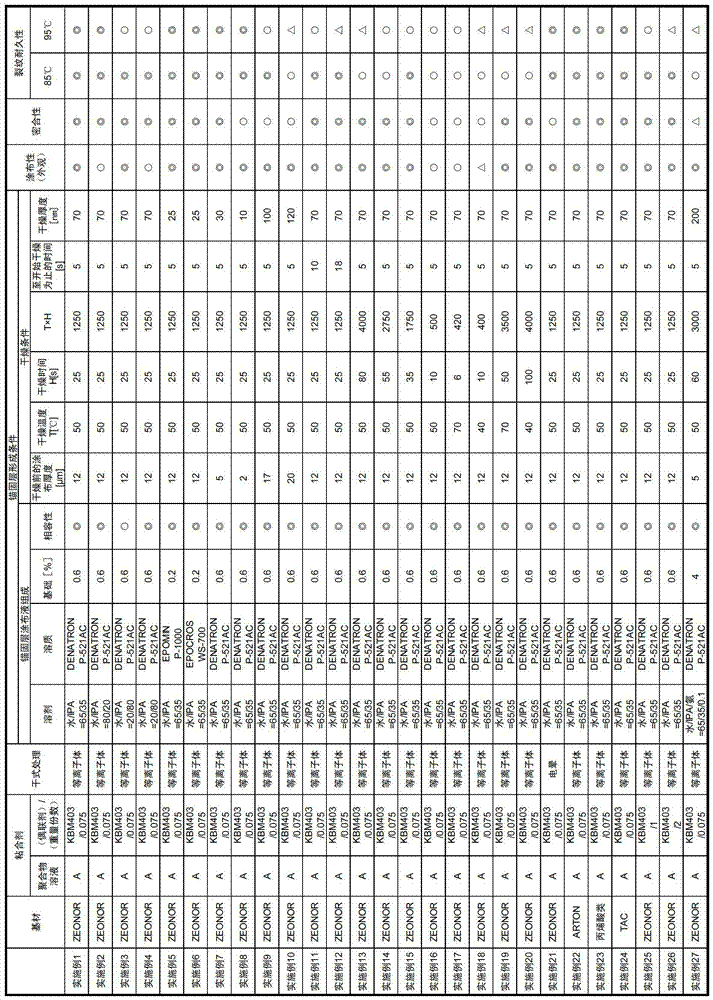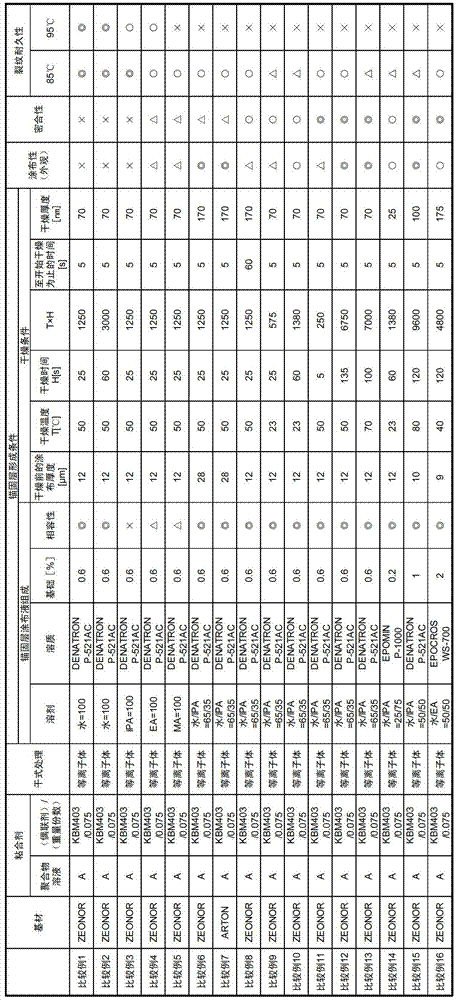Process for production of adhesive optical film
一种光学薄膜、制造方法的技术,应用在表面预处理的粘合方法、粘合剂类型、化学仪器和方法等方向,能够解决光学特性影响、无法满足高耐久性、光学薄膜溶剂龟裂等问题,达到提高密合性、提高涂布外观性、防止溶剂龟裂的效果
- Summary
- Abstract
- Description
- Claims
- Application Information
AI Technical Summary
Problems solved by technology
Method used
Image
Examples
Embodiment 1
[0132] (Production of optical films (polarizers))
[0133] A polyvinyl alcohol film with a thickness of 80 μm was dyed in a 0.3% iodine solution at 30° C. for 1 minute between rollers with different speed ratios, and stretched to 3 times. Then, it was immersed in an aqueous solution containing 60°C, 4% boric acid, and 10% potassium iodide for 0.5 minutes, and stretched to a total stretching ratio of 6 times. Next, after immersing in an aqueous solution containing 1.5% potassium iodide at 30° C. for 10 seconds to wash, and then drying at 50° C. for 4 minutes, a polarizing plate was obtained. A cellulose triacetate film (trade name "KC4UY", manufactured by Konica Minolta Holdings, Inc.) with a thickness of 40 μm was bonded to the viewing side of the polarizer with a polyvinyl alcohol-based adhesive, and on the side where the adhesive was applied A retardation plate made of a norbornene-based resin film with a thickness of 33 μm (trade name “ZEONOR FILM ZD12”, manufactured by ZE...
Embodiment 2~21 and 23~27
[0142] Embodiment 2~21 and 23~27, comparative example 1~5 and 7~15
[0143] In the optical film (polarizing plate), the retardation film shown in Table 2 and Table 3 was used instead of the retardation film (ZEONOR FILM ZD12) on the side where the anchor layer was formed. type optical film.
Embodiment 22 and comparative example 7
[0145] On the retardation plate (acrylic resin film) side of the acrylic polarizing plate used in Example 23, an adhesive layer (20 μm) obtained using the above-mentioned adhesive solution was formed, and then, as an adhesive retardation plate “ARTON ”; an optical film (substrate) (manufactured by JSR Corporation) made of a cyclic polyolefin resin (norbornene-based resin) is further laminated, and an anchor layer is formed on the side of the phase difference plate (ARTON). A pressure-sensitive adhesive optical film was produced in the same manner as in Example 1.
[0146] In Table 2 and Table 3, "substrate" indicates the retardation plate on the side where the anchor layer is formed, and "dry treatment" indicates the type of treatment performed on the side where the anchor layer is formed of the base material, and
[0147] "Acrylic" means an optical film formed from a lactone-modified acrylic resin,
[0148] "TAC" means an optical film formed of saponified cellulose triacetat...
PUM
| Property | Measurement | Unit |
|---|---|---|
| glass transition temperature | aaaaa | aaaaa |
| glass transition temperature | aaaaa | aaaaa |
| particle diameter | aaaaa | aaaaa |
Abstract
Description
Claims
Application Information
 Login to View More
Login to View More - R&D
- Intellectual Property
- Life Sciences
- Materials
- Tech Scout
- Unparalleled Data Quality
- Higher Quality Content
- 60% Fewer Hallucinations
Browse by: Latest US Patents, China's latest patents, Technical Efficacy Thesaurus, Application Domain, Technology Topic, Popular Technical Reports.
© 2025 PatSnap. All rights reserved.Legal|Privacy policy|Modern Slavery Act Transparency Statement|Sitemap|About US| Contact US: help@patsnap.com



